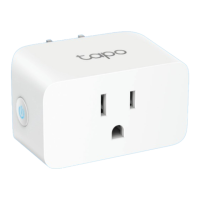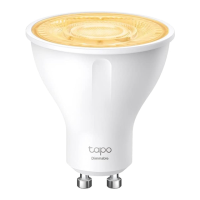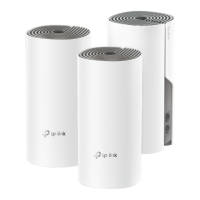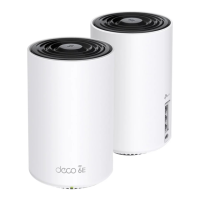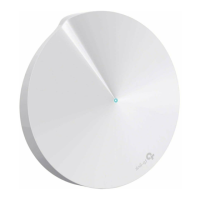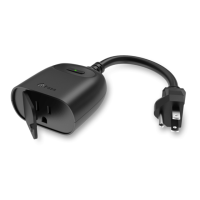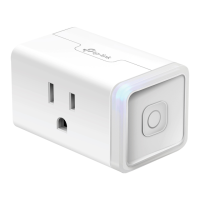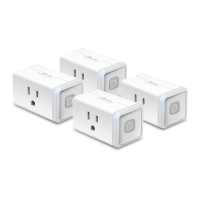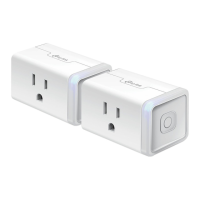Do you have a question about the TP-Link Tapo P125M and is the answer not in the manual?
Describes the formatting conventions used in the guide for clarity.
Provides helpful links for product specifications, support, and setup videos.
Enables seamless integration into preferred Matter ecosystems for smart home control.
Allows device management via voice commands with virtual assistants like Alexa and Google.
Enables control of connected devices from any location using the Tapo app.
Features for setting schedules and timers to automate device operation.
Simulates occupancy by randomly turning devices on and off.
Mini-sized to avoid obstructing adjacent electrical outlets.
Details the operations of the power button: on/off, settings retention, and factory reset.
The primary interface for connecting and controlling devices via the Tapo app.
Explains the meaning of different LED color and blinking patterns for device status.
Guide to obtaining the Tapo mobile application from app stores.
Steps for accessing the Tapo app with your TP-Link account credentials.
Instructions for adding the Tapo P125M plug within the Tapo application.
Guide for integrating the device with the Amazon Alexa ecosystem.
Guide for integrating the device with the Google Home ecosystem.
Guide for integrating the device with the Apple HomeKit ecosystem.
Common issues and solutions for setting up Matter-enabled devices.
Important considerations and requirements for Matter device setup.
Links to further guides and troubleshooting for Matter compatibility.
Conditions and recommendations before starting the Alexa integration process.
Verifying device and app compatibility for Matter setup with Alexa.
Lists compatible Amazon Echo devices for Matter integration.
Information regarding the required software version for Alexa app support.
Starting the setup process within the Alexa application.
Steps to begin adding a new device in the Alexa app.
Choosing the Matter option and navigating through setup screens.
Verifying if the device has a Matter logo during setup.
Using the QR code for device pairing with Alexa.
Connecting the device to your Wi-Fi network by entering the password.
Finalizing the setup and confirming the device is connected to Alexa.
Navigating to the device settings within the Alexa app.
Adding support for additional assistants and apps.
Obtaining the setup code for linking to another service.
Opening the app for the subsequent Matter ecosystem.
Verifying requirements for Google Home Matter integration.
Information about the Android version requirement for Google Home.
Lists compatible Google hardware for Matter control.
Information regarding the temporary nature of Matter pairing mode.
Opening the Google Home application to start the setup.
Steps to add a new device within the Google Home app.
Choosing the Matter option and confirming device setup.
Using the QR code to connect the device to Google Home.
Finalizing the connection and confirming the device is recognized by Google.
Setting a location and custom name for the device in Google Home.
Navigating to the device settings within the Google Home app.
Connecting the device to other Matter-enabled apps and services.
Utilizing a pairing code to link the device to another ecosystem.
Copying the generated pairing code for use in another app.
Opening the app for the subsequent Matter ecosystem to complete setup.
Verifying iOS and controller compatibility for Apple Matter integration.
Recommendation to update iOS devices for optimal Matter experience.
Information about the temporary nature of Matter pairing mode in Apple Home.
Starting the setup process within the Apple Home application.
Using the QR code to pair the device with Apple Home.
Setting a room location and custom name for the device in Apple Home.
Choosing how the device icon will appear in the Home app.
Navigating to the device settings within the Apple Home app.
Activating pairing mode and copying the setup code for other ecosystems.
Opening the app for the subsequent Matter ecosystem to complete setup.
Ensuring Matter hub and app firmware are up-to-date.
Verifying stable Wi-Fi connection for setup.
Restarting the Matter-enabled device to resolve setup issues.
Obtaining a new setup code for re-pairing with another ecosystem.
Understanding the time limits for Matter setup mode.
Restarting the smartphone and clearing the Smart Home app cache.
Suggestion to factory reset or use another device for configuration.
Navigating the Tapo app's home page to view and manage devices.
Using the device status page for one-tap control and customization.
Accessing settings for device information, control, and updates.
Creating schedules for automatic plug operation.
Setting up Away Mode for simulated presence.
Configuring timers for automatic on/off actions.
Customizing pre-defined shortcuts for quick actions.
Setting up automated tasks based on triggers and actions.
Defining conditions (When) for triggering automations.
Specifying tasks (Then) to be performed when a trigger occurs.
Option to delay the execution of an automation action.
Assigning a name and setting the effective time for automations.
Sharing device access through the Tapo app's status page.
Sharing device access via the 'Me' tab in the Tapo app.
Linking the Tapo device with voice assistants like Alexa and Google.
Choosing a specific voice assistant for control.
Statement regarding FCC regulations and device certification.
Information about the party responsible for FCC compliance.
Steps to correct potential radio interference.
Statement on compliance with FCC RF radiation exposure limits.
Declaration of compliance with technical standards and FCC part 15.
Compliance information for Industry Canada license-exempt RSSs.
Compliance with Industry Canada radiation exposure limits.
Formal statement regarding Canadian standards.
Notice regarding low-power radio frequency devices in Taiwan.
Important safety and usage guidelines from BSMI.
Important warnings regarding product usage, handling, and environment.
Declaration of restricted substances in the product's components.
Key safety guidelines for device operation and placement.
Guidance on operating environments and prohibited uses.
Precautions for electrical shock, overloading, and product handling.
Instructions for cleaning and maintaining the device.
Caution regarding potential interference with medical devices.
Guidelines for storing the product and operating environment conditions.
Potential interference issues with other electronic devices.
Recommended humidity levels for operation and storage.
Explanation of the integrated micro-disconnection switch.
Information about the device's portable nature and plug-in design.
Warning about the functional purpose of the integrated electronic switch.
Explanation of the symbol indicating indoor use only.
Explanation of the symbol representing AC voltage.
Information about the WEEE symbol and product recycling.
Describes the formatting conventions used in the guide for clarity.
Provides helpful links for product specifications, support, and setup videos.
Enables seamless integration into preferred Matter ecosystems for smart home control.
Allows device management via voice commands with virtual assistants like Alexa and Google.
Enables control of connected devices from any location using the Tapo app.
Features for setting schedules and timers to automate device operation.
Simulates occupancy by randomly turning devices on and off.
Mini-sized to avoid obstructing adjacent electrical outlets.
Details the operations of the power button: on/off, settings retention, and factory reset.
The primary interface for connecting and controlling devices via the Tapo app.
Explains the meaning of different LED color and blinking patterns for device status.
Guide to obtaining the Tapo mobile application from app stores.
Steps for accessing the Tapo app with your TP-Link account credentials.
Instructions for adding the Tapo P125M plug within the Tapo application.
Guide for integrating the device with the Amazon Alexa ecosystem.
Guide for integrating the device with the Google Home ecosystem.
Guide for integrating the device with the Apple HomeKit ecosystem.
Common issues and solutions for setting up Matter-enabled devices.
Important considerations and requirements for Matter device setup.
Links to further guides and troubleshooting for Matter compatibility.
Conditions and recommendations before starting the Alexa integration process.
Verifying device and app compatibility for Matter setup with Alexa.
Lists compatible Amazon Echo devices for Matter integration.
Information regarding the required software version for Alexa app support.
Starting the setup process within the Alexa application.
Steps to begin adding a new device in the Alexa app.
Choosing the Matter option and navigating through setup screens.
Verifying if the device has a Matter logo during setup.
Using the QR code for device pairing with Alexa.
Connecting the device to your Wi-Fi network by entering the password.
Finalizing the setup and confirming the device is connected to Alexa.
Navigating to the device settings within the Alexa app.
Adding support for additional assistants and apps.
Obtaining the setup code for linking to another service.
Opening the app for the subsequent Matter ecosystem.
Verifying requirements for Google Home Matter integration.
Information about the Android version requirement for Google Home.
Lists compatible Google hardware for Matter control.
Information regarding the temporary nature of Matter pairing mode.
Opening the Google Home application to start the setup.
Steps to add a new device within the Google Home app.
Choosing the Matter option and confirming device setup.
Using the QR code to connect the device to Google Home.
Finalizing the connection and confirming the device is recognized by Google.
Setting a location and custom name for the device in Google Home.
Navigating to the device settings within the Google Home app.
Connecting the device to other Matter-enabled apps and services.
Utilizing a pairing code to link the device to another ecosystem.
Copying the generated pairing code for use in another app.
Opening the app for the subsequent Matter ecosystem to complete setup.
Verifying iOS and controller compatibility for Apple Matter integration.
Recommendation to update iOS devices for optimal Matter experience.
Information about the temporary nature of Matter pairing mode in Apple Home.
Starting the setup process within the Apple Home application.
Using the QR code to pair the device with Apple Home.
Setting a room location and custom name for the device in Apple Home.
Choosing how the device icon will appear in the Home app.
Navigating to the device settings within the Apple Home app.
Activating pairing mode and copying the setup code for other ecosystems.
Opening the app for the subsequent Matter ecosystem to complete setup.
Ensuring Matter hub and app firmware are up-to-date.
Verifying stable Wi-Fi connection for setup.
Restarting the Matter-enabled device to resolve setup issues.
Obtaining a new setup code for re-pairing with another ecosystem.
Understanding the time limits for Matter setup mode.
Restarting the smartphone and clearing the Smart Home app cache.
Suggestion to factory reset or use another device for configuration.
Navigating the Tapo app's home page to view and manage devices.
Using the device status page for one-tap control and customization.
Accessing settings for device information, control, and updates.
Creating schedules for automatic plug operation.
Setting up Away Mode for simulated presence.
Configuring timers for automatic on/off actions.
Customizing pre-defined shortcuts for quick actions.
Setting up automated tasks based on triggers and actions.
Defining conditions (When) for triggering automations.
Specifying tasks (Then) to be performed when a trigger occurs.
Option to delay the execution of an automation action.
Assigning a name and setting the effective time for automations.
Sharing device access through the Tapo app's status page.
Sharing device access via the 'Me' tab in the Tapo app.
Linking the Tapo device with voice assistants like Alexa and Google.
Choosing a specific voice assistant for control.
Statement regarding FCC regulations and device certification.
Information about the party responsible for FCC compliance.
Steps to correct potential radio interference.
Statement on compliance with FCC RF radiation exposure limits.
Declaration of compliance with technical standards and FCC part 15.
Compliance information for Industry Canada license-exempt RSSs.
Compliance with Industry Canada radiation exposure limits.
Formal statement regarding Canadian standards.
Notice regarding low-power radio frequency devices in Taiwan.
Important safety and usage guidelines from BSMI.
Important warnings regarding product usage, handling, and environment.
Declaration of restricted substances in the product's components.
Key safety guidelines for device operation and placement.
Guidance on operating environments and prohibited uses.
Precautions for electrical shock, overloading, and product handling.
Instructions for cleaning and maintaining the device.
Caution regarding potential interference with medical devices.
Guidelines for storing the product and operating environment conditions.
Potential interference issues with other electronic devices.
Recommended humidity levels for operation and storage.
Explanation of the integrated micro-disconnection switch.
Information about the device's portable nature and plug-in design.
Warning about the functional purpose of the integrated electronic switch.
Explanation of the symbol indicating indoor use only.
Explanation of the symbol representing AC voltage.
Information about the WEEE symbol and product recycling.
| Type | Smart Plug |
|---|---|
| Wi-Fi Standard | 802.11 b/g/n |
| Frequency | 2.4 GHz |
| Input Voltage | 100-240V AC |
| Output Voltage | 100-240V AC |
| Maximum Load | 16A |
| Maximum Power | 3680W |
| Compatibility | Amazon Alexa, Google Assistant |
| App | Tapo |
| Scheduling | Yes |
| Away Mode | Yes |
| Timer | Yes |
| Energy Monitoring | Yes |
| Button | Power Button |
| Hub Required | No |
| Model | Tapo P125M |
| System Requirements | Android 4.4 or higher, iOS 9.0 or higher |
| Operating Temperature | 0°C to 40°C |
| Operating Humidity | 10% to 90% RH |
| Certifications | CE, RoHS |
